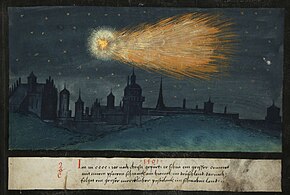 The comet in the Augsburg Book of Miracles, ca 1552 | |
| Discovery | |
|---|---|
| Discovery date | 8 February 1402 |
| Designations | |
| Great Comet of 1402 | |
| Orbital characteristics[1] | |
| Epoch | 21 March 1402 |
| Perihelion | 0.38 AU |
| Eccentricity | ~1.000 (assumed) |
| Inclination | 55.00° |
| 126.00° | |
| Argument of periapsis | 91.00° |
| Last perihelion | 21 March 1402 |
| Comet total magnitude (M1) | 0–1[2] |
The Great Comet of 1402 (designated as C/1402 D1 in modern nomenclature) was a bright comet seen between February and April 1402. The comet was reported to be visible in daylight for 8 days, the longest recorded for a comet.[2] The comet is mentioned in many chronicles, with most of them placing the comet in 1402, but it has been suggested that comets mentioned to be seen in 1401 and 1403 are in reality accounts with chronological errors of the great comet of 1402.[3]